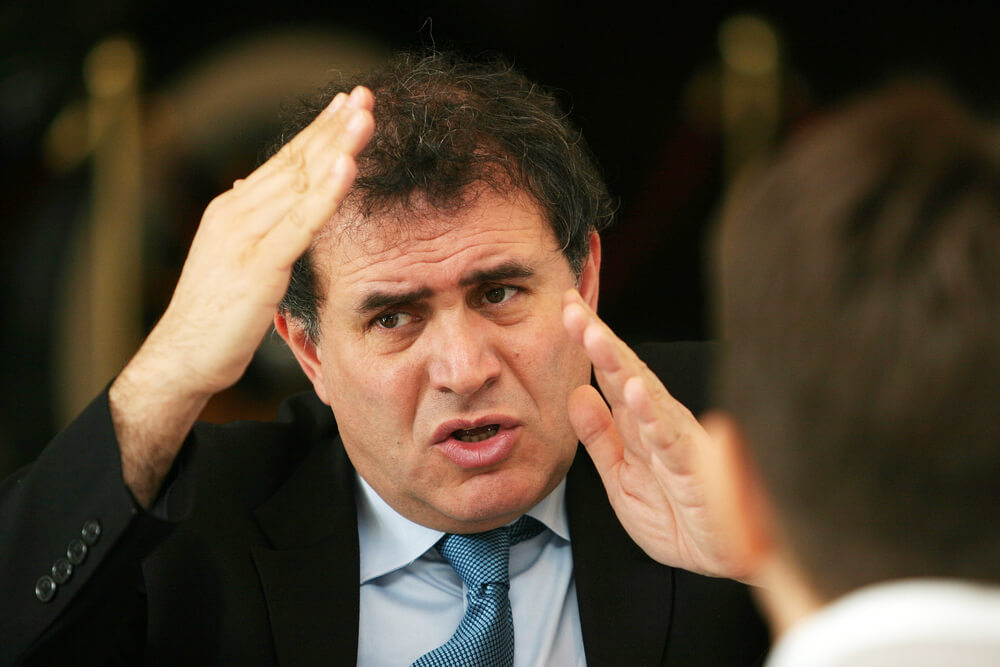Nouriel “Dr. Doom” Roubini penned an op-ed Thursday for the Financial Times in which he says “the worst is yet to come” from the coronavirus outbreak that has wreaked havoc on stock markets around the world this week.
Roubini, a professor of economics at Stern School of Business at New York University, correctly notes that reaction in the U.S. due to the virus, also known as COVID-19, has been painfully slow to hit markets, which dipped in January but then rallied to record highs as recently as last week. This complacency is what has led all three major U.S. indexes to crater into correction territory (10% decline) this week, with American traders making a few flawed assumptions.
“First, that the epidemic would be limited mostly to China, rather than becoming a global pandemic. Second, that it would be contained and peak before the end of the first quarter, thus limiting the economic damage to China and the global economy,” Roubini wrote. “Third, that the growth path would be V-shaped, with a strong rebound in the second quarter and beyond. Fourth, that policymakers — both monetary and fiscal — would take strong early actions to support economies and markets, if things were to weaken significantly.”
In reality, Roubini writes, the coronavirus is a global pandemic that is likely to get worse before it gets better with “severe” damage to the Chinese economy and beyond through supply chain disruptions. Goldman Sachs even went so far as to predict zero earnings growth for U.S. companies — for the entirety of 2020.
The damage will be far worse than the SARS outbreak because China now accounts for 20% of total global gross domestic product while only accounting for 4% way back in 2003.
Add to that an economic shock to big economies like Japan, South Korea and Italy,” Roubini wrote. “When the disease spreads to other developed and emerging markets, this damage will increase.”
The next step is a decline in consumer confidence due to all of the negative headlines.
“Even in the US where the contagion is so far limited, events are being cancelled and consumers are starting to prefer to stay home rather than go out,” Roubini wrote. “This is mild compared to what would happen if contagion truly hits the US, which is likely given the long latency of the disease.”
The best-case scenario is coronavirus only hits China during the first quarter and shrinks its GDP by 2%, meaning an annualized contraction of 8%. Assuming China rebounds the final three quarters, implying 4% growth for the year (down from 6% in 2019) “is heroically optimistic,” Roubini said. before predicting China’s growth will top out at 2.5% this year.
“Compare both the rosy and more realistic scenario with current market expectations, which have revised growth estimates for China from 6 per cent to 5.5 per cent, and you can see how investors are still delusional,” Roubini said. “An annual growth rate in the range of 2.5-4 per cent would also be a major shock to global growth and to other economies.”
And don’t expect central banks to save us.
“Central banks are running out of bullets: how much more negative can the European Central Bank, Bank of Japan and others go on interest rates? The US Federal Reserve has only 1.5 percentage points of headroom left. It will probably react in the second quarter by cutting rates, leading to short-term market relief,” Roubini explains. “But this coronavirus outbreak is mostly a negative supply shock that reduces growth and increases costs and inflation, with some side-effects for aggregate demand. Monetary policy cannot resolve this.”
Roubini closes by noting investors should expect a short bounce when the Fed does act to cut rates, but it will basically amount to a dead cat bounce as the virus becomes more severe. The potential for a U.S.-Iran war coupled with political chaos from foreign interference in the 2020 election and escalating tensions with China, Roubini contends, is a recipe for disaster.
Take all of this together,” Roubini wrote, “and the risk of a global recession is rising.”




